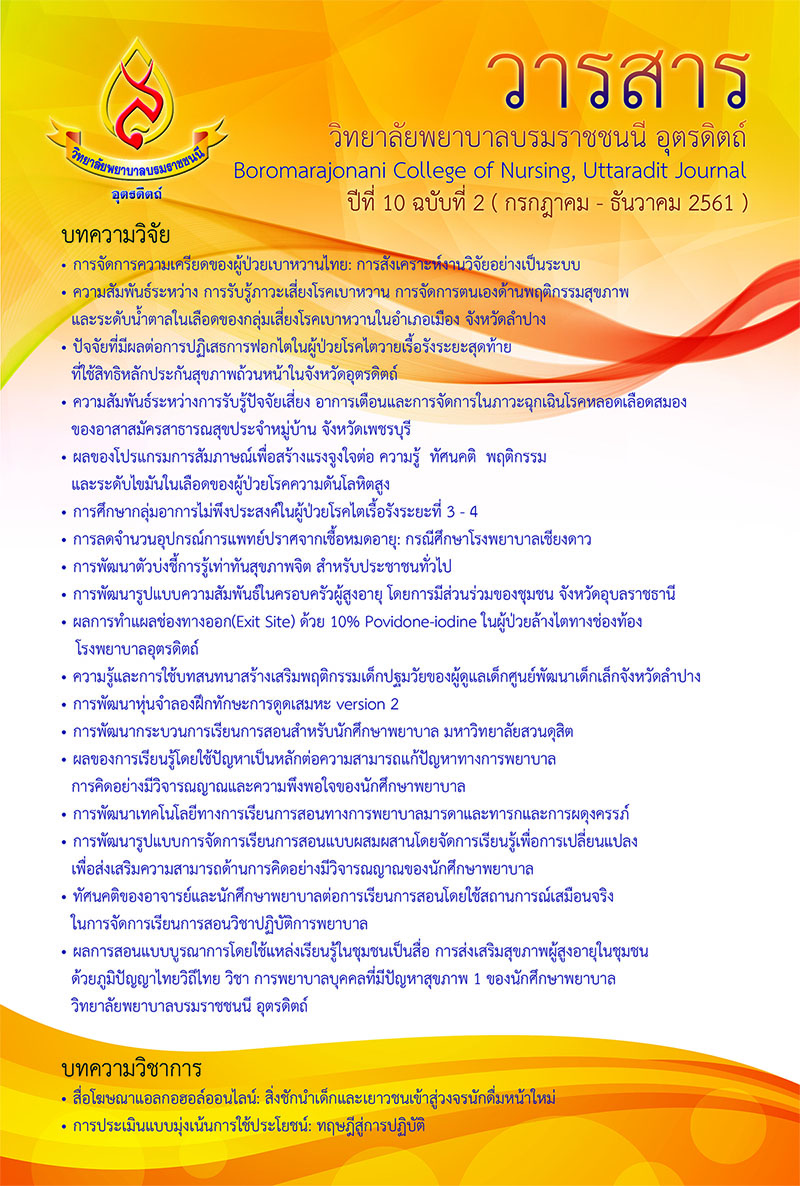การศึกษากลุ่มอาการไม่พึงประสงค์ในผู้ป่วยโรคไตเรื้อรังระยะที่ 3 - 4
Main Article Content
บทคัดย่อ
การวิจัยครั้งนี้เป็นการวิจัยเชิงพรรณนา เพื่อศึกษากลุ่มอาการไม่พึงประสงค์ในผู้ป่วยโรคไตเรื้อรังโดยใช้ทฤษฎีอาการไม่พึงประสงค์ (Theory of Unpleasant Symptoms) เป็นกรอบแนวคิด กลุ่มตัวอย่างเป็นผู้ป่วยโรคไตเรื้อรังระยะที่ 3-4 ที่มารับบริการที่คลินิกผู้ป่วยนอกโรคไตเรื้อรัง โรงพยาบาลระดับตติยภูมิแห่งหนึ่ง ในจังหวัดร้อยเอ็ด ระหว่างเดือนมกราคม - มีนาคม 2559 คัดเลือกกลุ่มตัวอย่างแบบเฉพาะเจาะจงตามคุณสมบัติที่กำหนด จำนวน 150 ราย เครื่องมือที่ใช้เป็นแบบประเมินอาการไม่พึงประสงค์ในผู้ป่วยโรคไตเรื้อรัง วิเคราะห์ข้อมูลด้วยสถิติเชิงพรรณนา และสถิติวิเคราะห์องค์ประกอบ (Factor analysis) กำหนดค่านัยสำคัญทางสถิติที่ .05
ผลการศึกษาพบว่า ผู้ป่วยโรคไตเรื้อรังระยะ 3-4 มีอาการไม่พึงประสงค์ 28 อาการ เฉลี่ย 7.44 อาการ (SD = 3.76) สามารถจัดเป็นกลุ่มอาการไม่พึงประสงค์หลักตามมิติความถี่ มิติความรุนแรง และมิติรวมความถี่และความรุนแรง ได้ 6 กลุ่ม อธิบายความแปรปรวนสะสมได้ร้อยละ 43.536 ร้อยละ 42.924 และร้อยละ 41.647 ตามลำดับ ประกอบด้วย 1) กลุ่มอาการทางจิตใจและอารมณ์ 2) กลุ่มอาการผิดปกติของประสาทส่วนปลาย 3) กลุ่มอาการอ่อนเพลีย 4) กลุ่มอาการระบบทางเดินอาหาร 5) กลุ่มอาการปวด และ 6) กลุ่มอาการของเสียคั่ง
การศึกษาครั้งนี้แสดงให้เห็นว่า ผู้ป่วยโรคไตเรื้อรังระยะที่ 3-4 อาการไม่พึงประสงค์ในมิติความถี่ ความรุนแรง และความถี่รวมกับความรุนแรงจัดรวมเป็นกลุ่มอาการได้เหมือนกัน พยาบาลสามารถประเมินอาการไม่พึงประสงค์มิติใดมิติหนึ่ง และวางแผนการดูแลจัดการกลุ่มอาการไม่พึงประสงค์ตามที่พบในการศึกษานี้
Article Details
บทความหรือข้อคิดเห็นใดใดที่ปรากฏในวารสารวิจัยการพยาบาลและวิทยาศาสตร์สุขภาพ เป็นวรรณกรรมของผู้เขียน ซึ่งบรรณาธิการหรือสมาคมศิษย์เก่า ไม่จำเป็นต้องเห็นด้วย และบทความที่ได้รับการตีพิมพ์เผยแพร่ถือเป็นลิขสิทธิ์ของวารสารวิจัยการพยาบาลและวิทยาศาสตร์สุขภาพ
เอกสารอ้างอิง
2. Almutary, H., Bonner, A., & Douglas, C. (2013). Symptom burden in chronic kidney disease: a review of recent literature. Journal of renal care, 39(3), 140-150. doi: 10.1111/j.1755-6686.2013.12022
3. Almutary, H., Douglas, C., & Bonner, A. (2016). Multidimensional symptom clusters: an exploratory factor analysis in advanced chronic kidney disease. Journal of advanced nursing, 72(10), 2389-2400.
4. Bannasitrath, R. (2010). Anxiety depression and psychosocial factors in patients with chronic kidney disease in department of Medicine King Chulalongkorn Memorial Hospital. A Dissertation submitted in Partial Fulfillment of the Requirement for the Master of Science in Mental Health Faculty of Medicine, Chulalongkorn University. (in Thai).
5. Berger, T. G., & Steinhoff, M. (2011). Pruritus and renal failure. Seminars in Cutaneous Medicine and Surgery, 30(2), 99–100. doi:10.1016/j.sder.2011.04.005
6. Bonner, A., Wellard, S., & Caltabiano, M. (2010). The impact of fatigue on daily activity in people with chronic kidney disease. Journal of Clinical Nursing, 19(21-22), 3006-3015. doi:10.1111/j.1365-2702.2010.03381.x
7. Carrero, J. J., Aguilera, A., Stenvinkel, P., Gil, F., Selgas, R. & Lindholm, B. (2008). Appetite Disorders in Uremia. Journal of Renal Nutrition, 18(1), 107-113. doi:10.1053/j.jrn.2007.10.022
8. Cohen, S. D., Patel, S. S., Khetpal, P., Peterson, R. A., & Kimmel, P. L. (2007). Pain, sleepdisturbance, and quality of life in patients with chronic kidney disease. Clinical Journal of the American Society of Nephrology, 2(5), 919-925. doi:10.2215/CJN.00820207
9. Jitchan, P., Masingboon, K. & Duanpaeng, S. (2011). Predictors of Functional Performance inPatients with Chronic Kidney Disease. Thai Journal of Nursing Council, 26(2): 86-99. (in Thai).
10. Krishnan, A. V., & Kiernan, M. C. (2007). Uremic neuropathy: clinical features and newpathophysiological insights. Muscle & nerve, 35(3), 273-290.
11. Lee, S. E., Vincent, C., & Finnegan, L. (2017). An Analysis and Evaluation of the Theory ofUnpleasant Symptoms. Advances in Nursing Science, 40(1), E16-E39.
12. Lee, S.J., & Jeon, J. (2015). Relationship between symptom clusters and quality of life in patients at stages 2 to 4 chronic kidney disease in Korea, Applied Nursing Research (2015). doi.org/10.1016/j.apnr.2015.03.004
13. Lee, Y. J., Kim, M. S., Cho, S., & Kim, S. R. (2013). Association of depression and anxiety with reduced quality of life in patients with predialysis chronic kidney disease. International journal of clinical practice, 67(4), 363-368.doi:10.1111/ijcp.12020
14. Lenz, E., Pugh, L., Milligan, R., Gift, A., & Suppe, F. (1997). The middle range theory ofunpleasant symptom: An update. Advance in Nursing Science, 19(3), 14-27.
15. Miaskowski, C., Dodd, M., & Lee, K. A. (2004). Symptom clusters: the new frontier in symptom management research. Journal of the National Cancer Institute Monographs, 32, 17- 21. doi:10.1093/jncimonographs/lgh023
16. Murphy, E. L., Murtagh, F. E., Carey, I., & Sheerin, N. S. (2008). Understanding symptoms in patients with advanced chronic kidney disease managed without dialysis: use of a short patient-completed assessment tool. Nephro Clinical practice, 111(1), 74-80. doi:10.1159/000183177
17. National Kidney Foundation. (2012). KDOQI clinical practice guideline for diabetes and CKD:2012 update. American Journal of Kidney Diseases, 60(5), 850-886.doi:10.1053/j.ajkd.2012.07.005
18. Nephrology Society of Thailand. (2015). Clinical practice recommendation for theevaluation and management of chronic kidney disease in adults 2015. Bangkok. (in Thai).
19. Pongpoottipatchara, R., Sriyuktasuth, A., Saneha, C. & Vongsirimas, N. (2013). Factors influencing quality of life in pre- dialysis chronic kidney disease patients. Journal of Nursing and Health Care, 31(1), 52-61. (in Thai).
20. Skerman, H. M., Yates, P. M., & Battistutta, D. (2009). Multivariate methods to identify cancer related symptom clusters. Research in nursing & health, 32(3), 345-360.
21.Skerman, H. M., Yates, P. M., & Battistutta, D. (2012). Identification of cancer-related symptom clusters: an empirical comparison of exploratory factor analysis methods. Journal of pain and symptom management, 44(1), 10-22.
22. Singchongchai, P. (2006). Principles and using multivariate statistics analysis for nursing research. Songkhla: Chanmuang printing. (in Thai).
23. Sutheechai, S. & Sudchada, P. (2012). Mineral and bone disorder in chronic kidney disease. Srinagarind Medical Journal, 27(4), 415-423. (in Thai)
24. Taiwong, A., Kanogsunthornrat, N. & Chiwiboonthum, S. (2017). Relationship between unpleasant symptom clusters and quality of life among patients with chronic kidney disease. Journal of Nursing and Health Care, 35(3), 120-128. (in Thai).
25. Wongsaree, C. (2016). Perception of and self-management in sexuality dysfunction among male patients with end-stage renal disease receiving hemodialysis, Journal of Nursing Science Chulalongkorn University, 28(3), 55-67. (in Thai).


